+ Open data
Open data
- Basic information
Basic information
| Entry | Database: PDB / ID: 6dzh | ||||||
|---|---|---|---|---|---|---|---|
| Title | HRAS G13D bound to GDP (H13GDP) | ||||||
 Components Components | GTPase HRas | ||||||
 Keywords Keywords | SIGNALING PROTEIN / Oncogene / RAS / p21 | ||||||
| Function / homology |  Function and homology information Function and homology informationphospholipase C activator activity / GTPase complex / oncogene-induced cell senescence / positive regulation of miRNA metabolic process / positive regulation of ruffle assembly / T-helper 1 type immune response / positive regulation of wound healing / defense response to protozoan / regulation of neurotransmitter receptor localization to postsynaptic specialization membrane / Signaling by RAS GAP mutants ...phospholipase C activator activity / GTPase complex / oncogene-induced cell senescence / positive regulation of miRNA metabolic process / positive regulation of ruffle assembly / T-helper 1 type immune response / positive regulation of wound healing / defense response to protozoan / regulation of neurotransmitter receptor localization to postsynaptic specialization membrane / Signaling by RAS GAP mutants / Signaling by RAS GTPase mutants / Activation of RAS in B cells / RAS signaling downstream of NF1 loss-of-function variants / SOS-mediated signalling / Activated NTRK3 signals through RAS / Activated NTRK2 signals through RAS / positive regulation of protein targeting to membrane / SHC1 events in ERBB4 signaling / Signalling to RAS / adipose tissue development / Activated NTRK2 signals through FRS2 and FRS3 / SHC-related events triggered by IGF1R / Estrogen-stimulated signaling through PRKCZ / Schwann cell development / SHC-mediated cascade:FGFR3 / MET activates RAS signaling / SHC-mediated cascade:FGFR2 / PTK6 Regulates RHO GTPases, RAS GTPase and MAP kinases / Signaling by PDGFRA transmembrane, juxtamembrane and kinase domain mutants / Signaling by PDGFRA extracellular domain mutants / SHC-mediated cascade:FGFR4 / Erythropoietin activates RAS / SHC-mediated cascade:FGFR1 / Signaling by FGFR4 in disease / FRS-mediated FGFR3 signaling / Signaling by FLT3 ITD and TKD mutants / FRS-mediated FGFR2 signaling / FRS-mediated FGFR4 signaling / p38MAPK events / FRS-mediated FGFR1 signaling / Signaling by FGFR3 in disease / protein-membrane adaptor activity / Tie2 Signaling / Signaling by FGFR2 in disease / myelination / GRB2 events in EGFR signaling / EPHB-mediated forward signaling / SHC1 events in EGFR signaling / Signaling by FLT3 fusion proteins / FLT3 Signaling / Signaling by FGFR1 in disease / EGFR Transactivation by Gastrin / NCAM signaling for neurite out-growth / CD209 (DC-SIGN) signaling / GRB2 events in ERBB2 signaling / Downstream signal transduction / intrinsic apoptotic signaling pathway / Insulin receptor signalling cascade / Ras activation upon Ca2+ influx through NMDA receptor / SHC1 events in ERBB2 signaling / Constitutive Signaling by Overexpressed ERBB2 / Signaling by phosphorylated juxtamembrane, extracellular and kinase domain KIT mutants / animal organ morphogenesis / VEGFR2 mediated cell proliferation / positive regulation of epithelial cell proliferation / small monomeric GTPase / regulation of actin cytoskeleton organization / positive regulation of JNK cascade / FCERI mediated MAPK activation / RAF activation / Signaling by ERBB2 TMD/JMD mutants / cellular response to gamma radiation / Signaling by SCF-KIT / Signaling by high-kinase activity BRAF mutants / Constitutive Signaling by EGFRvIII / regulation of long-term neuronal synaptic plasticity / MAP2K and MAPK activation / Signaling by ERBB2 ECD mutants / Signaling by ERBB2 KD Mutants / positive regulation of type II interferon production / endocytosis / positive regulation of fibroblast proliferation / chemotaxis / Regulation of RAS by GAPs / RAS processing / Negative regulation of MAPK pathway / Signaling by RAF1 mutants / Signaling by moderate kinase activity BRAF mutants / Paradoxical activation of RAF signaling by kinase inactive BRAF / Signaling downstream of RAS mutants / GDP binding / Signaling by BRAF and RAF1 fusions / cellular senescence / insulin receptor signaling pathway / DAP12 signaling / T cell receptor signaling pathway / MAPK cascade / Constitutive Signaling by Ligand-Responsive EGFR Cancer Variants / regulation of cell population proliferation / G protein activity Similarity search - Function | ||||||
| Biological species |  Homo sapiens (human) Homo sapiens (human) | ||||||
| Method |  X-RAY DIFFRACTION / X-RAY DIFFRACTION /  MOLECULAR REPLACEMENT / Resolution: 1.95 Å MOLECULAR REPLACEMENT / Resolution: 1.95 Å | ||||||
 Authors Authors | Johnson, C.W. / Mattos, C. | ||||||
| Funding support |  United States, 1items United States, 1items
| ||||||
 Citation Citation |  Journal: Cell Rep / Year: 2019 Journal: Cell Rep / Year: 2019Title: Isoform-Specific Destabilization of the Active Site Reveals a Molecular Mechanism of Intrinsic Activation of KRas G13D. Authors: Johnson, C.W. / Lin, Y.J. / Reid, D. / Parker, J. / Pavlopoulos, S. / Dischinger, P. / Graveel, C. / Aguirre, A.J. / Steensma, M. / Haigis, K.M. / Mattos, C. | ||||||
| History |
|
- Structure visualization
Structure visualization
| Structure viewer | Molecule:  Molmil Molmil Jmol/JSmol Jmol/JSmol |
|---|
- Downloads & links
Downloads & links
- Download
Download
| PDBx/mmCIF format |  6dzh.cif.gz 6dzh.cif.gz | 118.2 KB | Display |  PDBx/mmCIF format PDBx/mmCIF format |
|---|---|---|---|---|
| PDB format |  pdb6dzh.ent.gz pdb6dzh.ent.gz | 88.2 KB | Display |  PDB format PDB format |
| PDBx/mmJSON format |  6dzh.json.gz 6dzh.json.gz | Tree view |  PDBx/mmJSON format PDBx/mmJSON format | |
| Others |  Other downloads Other downloads |
-Validation report
| Summary document |  6dzh_validation.pdf.gz 6dzh_validation.pdf.gz | 1.4 MB | Display |  wwPDB validaton report wwPDB validaton report |
|---|---|---|---|---|
| Full document |  6dzh_full_validation.pdf.gz 6dzh_full_validation.pdf.gz | 1.4 MB | Display | |
| Data in XML |  6dzh_validation.xml.gz 6dzh_validation.xml.gz | 22.7 KB | Display | |
| Data in CIF |  6dzh_validation.cif.gz 6dzh_validation.cif.gz | 31.6 KB | Display | |
| Arichive directory |  https://data.pdbj.org/pub/pdb/validation_reports/dz/6dzh https://data.pdbj.org/pub/pdb/validation_reports/dz/6dzh ftp://data.pdbj.org/pub/pdb/validation_reports/dz/6dzh ftp://data.pdbj.org/pub/pdb/validation_reports/dz/6dzh | HTTPS FTP |
-Related structure data
| Related structure data | 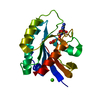 6e6cC 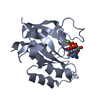 6e6fC  6e6gC  6e6hC 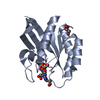 6e6pSC C: citing same article ( S: Starting model for refinement |
|---|---|
| Similar structure data |
- Links
Links
- Assembly
Assembly
| Deposited unit | 
| ||||||||
|---|---|---|---|---|---|---|---|---|---|
| 1 | 
| ||||||||
| 2 | 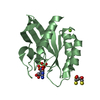
| ||||||||
| 3 | 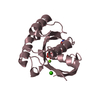
| ||||||||
| Unit cell |
|
- Components
Components
-Protein , 1 types, 3 molecules ABC
| #1: Protein | Mass: 18933.227 Da / Num. of mol.: 3 / Fragment: residues 1-166 / Mutation: G13D Source method: isolated from a genetically manipulated source Source: (gene. exp.)  Homo sapiens (human) / Gene: HRAS, HRAS1 / Plasmid: pET21 / Production host: Homo sapiens (human) / Gene: HRAS, HRAS1 / Plasmid: pET21 / Production host:  |
|---|
-Non-polymers , 6 types, 257 molecules 



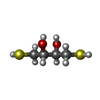






| #2: Chemical | | #3: Chemical | ChemComp-MG / #4: Chemical | ChemComp-GOL / | #5: Chemical | #6: Chemical | ChemComp-DTT / | #7: Water | ChemComp-HOH / | |
|---|
-Experimental details
-Experiment
| Experiment | Method:  X-RAY DIFFRACTION / Number of used crystals: 1 X-RAY DIFFRACTION / Number of used crystals: 1 |
|---|
- Sample preparation
Sample preparation
| Crystal grow | Temperature: 291.15 K / Method: vapor diffusion, hanging drop / pH: 7.5 Details: 5.9% stabilization buffer (20 mM HEPES, 50 mM NaCl, 20 mM MgCl2, pH 7.5) 188.2 mM Calcium Acetate 18.8% PEG 3350 Crystals were grown in 2uL by 2uL drops of mother liquor to protein (7.7mg/mL) ...Details: 5.9% stabilization buffer (20 mM HEPES, 50 mM NaCl, 20 mM MgCl2, pH 7.5) 188.2 mM Calcium Acetate 18.8% PEG 3350 Crystals were grown in 2uL by 2uL drops of mother liquor to protein (7.7mg/mL) Cryoprotectant for crystal diffraction: 70% mother liquor and 30% glycerol |
|---|
-Data collection
| Diffraction | Mean temperature: 100 K | |||||||||||||||||||||||||||||||||||||||||||||||||||||||||||||||||||||||||||||||||||||||||||||||||||||||||||||||||||||||||||||||||||||||||||||||||||||||||||||||||||||||||||||||||||||||||||||
|---|---|---|---|---|---|---|---|---|---|---|---|---|---|---|---|---|---|---|---|---|---|---|---|---|---|---|---|---|---|---|---|---|---|---|---|---|---|---|---|---|---|---|---|---|---|---|---|---|---|---|---|---|---|---|---|---|---|---|---|---|---|---|---|---|---|---|---|---|---|---|---|---|---|---|---|---|---|---|---|---|---|---|---|---|---|---|---|---|---|---|---|---|---|---|---|---|---|---|---|---|---|---|---|---|---|---|---|---|---|---|---|---|---|---|---|---|---|---|---|---|---|---|---|---|---|---|---|---|---|---|---|---|---|---|---|---|---|---|---|---|---|---|---|---|---|---|---|---|---|---|---|---|---|---|---|---|---|---|---|---|---|---|---|---|---|---|---|---|---|---|---|---|---|---|---|---|---|---|---|---|---|---|---|---|---|---|---|---|---|---|
| Diffraction source | Source:  ROTATING ANODE / Type: RIGAKU MICROMAX-007 HF / Wavelength: 1.54178 Å ROTATING ANODE / Type: RIGAKU MICROMAX-007 HF / Wavelength: 1.54178 Å | |||||||||||||||||||||||||||||||||||||||||||||||||||||||||||||||||||||||||||||||||||||||||||||||||||||||||||||||||||||||||||||||||||||||||||||||||||||||||||||||||||||||||||||||||||||||||||||
| Detector | Type: RIGAKU RAXIS IV++ / Detector: IMAGE PLATE / Date: Nov 25, 2014 | |||||||||||||||||||||||||||||||||||||||||||||||||||||||||||||||||||||||||||||||||||||||||||||||||||||||||||||||||||||||||||||||||||||||||||||||||||||||||||||||||||||||||||||||||||||||||||||
| Radiation | Protocol: SINGLE WAVELENGTH / Monochromatic (M) / Laue (L): M / Scattering type: x-ray | |||||||||||||||||||||||||||||||||||||||||||||||||||||||||||||||||||||||||||||||||||||||||||||||||||||||||||||||||||||||||||||||||||||||||||||||||||||||||||||||||||||||||||||||||||||||||||||
| Radiation wavelength | Wavelength: 1.54178 Å / Relative weight: 1 | |||||||||||||||||||||||||||||||||||||||||||||||||||||||||||||||||||||||||||||||||||||||||||||||||||||||||||||||||||||||||||||||||||||||||||||||||||||||||||||||||||||||||||||||||||||||||||||
| Reflection | Resolution: 1.95→50 Å / Num. all: 175532 / Num. obs: 25256 / % possible obs: 82 % / Redundancy: 6.5 % / Rmerge(I) obs: 0.092 / Rpim(I) all: 0.037 / Rrim(I) all: 0.1 / Χ2: 0.944 / Net I/σ(I): 8.1 / Num. measured all: 175531 | |||||||||||||||||||||||||||||||||||||||||||||||||||||||||||||||||||||||||||||||||||||||||||||||||||||||||||||||||||||||||||||||||||||||||||||||||||||||||||||||||||||||||||||||||||||||||||||
| Reflection shell | Diffraction-ID: 1
|
- Processing
Processing
| Software |
| ||||||||||||||||||
|---|---|---|---|---|---|---|---|---|---|---|---|---|---|---|---|---|---|---|---|
| Refinement | Method to determine structure:  MOLECULAR REPLACEMENT MOLECULAR REPLACEMENTStarting model: 6E6P Resolution: 1.95→35.7 Å / Cross valid method: FREE R-VALUE
| ||||||||||||||||||
| Displacement parameters | Biso max: 70.97 Å2 / Biso mean: 25.6642 Å2 / Biso min: 6.96 Å2 | ||||||||||||||||||
| Refinement step | Cycle: LAST / Resolution: 1.95→35.7 Å
|
 Movie
Movie Controller
Controller





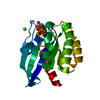



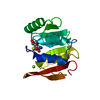

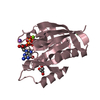
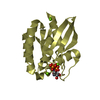
 PDBj
PDBj


























